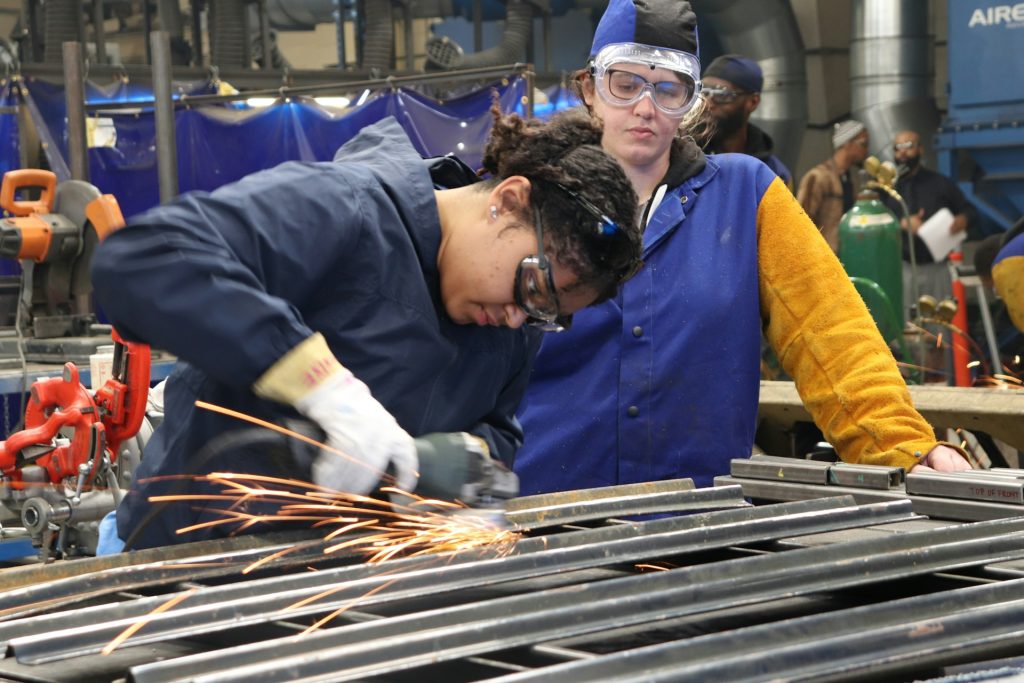 Everyone’s suddenly talking about trade jobs like they’re the answer to America’s career crisis. Skip the four-year degree, they say. Avoid student debt. Make $100,000 as an electrician. Be your own boss.
Everyone’s suddenly talking about trade jobs like they’re the answer to America’s career crisis. Skip the four-year degree, they say. Avoid student debt. Make $100,000 as an electrician. Be your own boss.
Some of that is true. Trade jobs do offer legitimate career paths that don’t require college degrees. Many trades pay well, especially after you’ve put in years building skills and reputation. And yes, the country desperately needs skilled workers because an entire generation of tradespeople is retiring.
But the conversation around trades has gotten overly romanticized, especially by people who’ve never worked in them. Trade work is physically demanding. The training path isn’t as simple as “do an apprenticeship and you’re set.” Pay varies wildly by location, union status, and specialization. And that six-figure income everyone mentions? Most trade workers never get there, and those who do have often destroyed their bodies by age 50.
If you’re seriously considering a trade career, you need the unfiltered reality—what the work actually entails, how to break in without wasting time and money, what you’ll really earn, and whether your body can handle it for 30 years.
Read Also: Hotel Jobs in the USA: What It’s Really Like Working in Hospitality
What Trade Jobs Actually Mean (The Daily Reality)
Let’s start with what you’re actually doing, because “trade jobs” cover an enormous range of jobs with very different day-to-day experiences.
Electricians
They pull wire through tight spaces, bend conduit, troubleshoot circuits, and work in attics when it’s 110 degrees or crawl spaces filled with insulation and spiders. You’re reading blueprints, calculating loads, testing voltage, installing panels and outlets, and lighting. Sometimes you’re in new construction working on clean, empty buildings. Sometimes you’re in occupied buildings trying to upgrade old wiring without killing power or burning the place down.
The work is technical—you need to understand electrical theory, code requirements, and safety procedures. But it’s also physical. You’re climbing ladders, lifting heavy boxes of wire and equipment, working overhead until your shoulders burn, kneeling on concrete until your knees are shot. And one mistake can kill you or burn down a building.
Plumbers
They deal with water, waste, and gas lines. You’re installing toilets and sinks, and water heaters in new construction. You’re snaking drains clogged with hair and grease, and things we won’t mention. Also, you’re crawling under houses through mud to fix leaking pipes. You’re soldering copper, threading pipe, and pressure-testing systems.
The work pays well because it’s physically demanding, and most people don’t want to do it. You’re working in cramped spaces, dealing with other people’s waste, getting soaked when things break, and carrying heavy pipe and fixtures. And emergency calls come at 2 AM when someone’s basement is flooding.
HVAC technicians
They install and service heating and cooling systems. You’re on roofs in summer heat, working on commercial AC units. You’re in the attic installing ductwork. Also, you’re troubleshooting why someone’s furnace died in the middle of winter. Furthermore, you’re working with refrigerants that can cause frostbite, electrical systems that can electrocute you, and equipment that weighs hundreds of pounds.
Peak seasons are brutal—everyone needs AC fixed right now when it’s 95 degrees outside, and you’re working 12-hour days six days a week. But winter can be slow in warm climates, and your income fluctuates unless you’re on a salary.
Welders
They work with extreme heat, bright light, and molten metal. You’re in manufacturing plants, construction sites, shipyards, or fab shops, creating permanent metal joints using various welding processes. The work requires steady hands, good eyesight, and the ability to pass certification tests that prove your welds meet standards.
You’re wearing protective gear in hot conditions. You’re breathing fumes even with ventilation. Additionally, you’re working in awkward positions—overhead, vertical, in confined spaces. And the bright arc can damage your eyes if you’re not careful. But good welders are always in demand, and specialized welding (underwater, pipeline, nuclear) pays exceptionally well.
Construction equipment operators
They run excavators, bulldozers, cranes, loaders, and other heavy machinery. You’re moving earth, lifting loads, grading sites, and digging foundations. The machinery is expensive and dangerous—mistakes can kill people or destroy equipment worth hundreds of thousands.
The work requires spatial awareness, steady nerves, and the ability to sit in a machine for 10 hours, concentrating on what you’re doing. Weather affects you—construction shuts down in heavy rain or snow, which means no work and no pay if you’re hourly.
These are just snapshots, but they illustrate something important: trade work is physically demanding, often uncomfortable, sometimes dangerous, and requires genuine skill and judgment. It’s not “easy money” for people who don’t want to think. It’s skilled labor that breaks your body over time.
Read Also: Work and Travel Opportunities in the USA
The Apprenticeship Path (And Why It’s Harder Than It Sounds)
 Everyone says “just do an apprenticeship” like it’s a simple, obvious path. In reality, apprenticeships are competitive, complicated, and vary wildly by trade and location.
Everyone says “just do an apprenticeship” like it’s a simple, obvious path. In reality, apprenticeships are competitive, complicated, and vary wildly by trade and location.
Union apprenticeships
These are the gold standard in many trades—especially electrical, plumbing, pipefitting, and some construction specialties. You apply, take an aptitude test, interview, and if accepted, you’re in a multi-year program that combines classroom learning with paid on-the-job work.
The benefits are real: structured training, guaranteed wage increases as you progress, eventual journeyman certification, strong pay and benefits once you’re in. Union electricians in major cities can make $80,000 to $120,000+ with great benefits.
The downsides: competition is intense. Some union apprenticeships get 1,000 applicants for 30 spots. You might apply multiple years before getting in. There are wait lists. There’s politics—knowing someone in the union helps enormously. And some unions have restrictive practices about where you can work or whether you can do side jobs.
Non-union apprenticeships
There are easier to get into but often pay less and offer weaker benefits. You’re working for a private contractor who trains you while you help on jobs. The quality of training depends entirely on who’s teaching you—some contractors are excellent mentors, others just want cheap labor and teach you the bare minimum.
Pay starts low—maybe $15 to $18 per hour—and increases annually as you gain skills. But you’re at the mercy of your employer’s business success. If they’re slow, you’re not working. If they go under, you need to find another apprenticeship and hope your hours transfer toward certification.
Trade schools
Trade schools offer another route. You pay tuition ($5,000 to $30,000 depending on program length and location) for classroom and hands-on training in welding, HVAC, automotive technology, or other trades. Programs range from six months to two years.
The trap: many trade schools overpromise. They’ll tell you their graduates make $60,000+ immediately, but that’s often the high end after years of experience, not starting pay. They’ll imply job placement is guaranteed, but that really means they’ll give you a list of companies that sometimes hire. And some for-profit trade schools are predatory—charging outrageous tuition for training you could get cheaper or free elsewhere.
Do your research. Community college trade programs are usually cheaper and better value than for-profit schools. Talk to people actually working in the trade before enrolling anywhere. And understand that trade school gives you knowledge but not certification—you still need work experience and often apprenticeship hours before you can work independently.
Read Also: Vocational Schools in the USA
What You’ll Actually Earn (And Why Location Matters More Than Anything)
 The internet is full of articles claiming electricians make $100,000 and plumbers make $90,000, and every trade is a six-figure career. That’s misleading at best.
The internet is full of articles claiming electricians make $100,000 and plumbers make $90,000, and every trade is a six-figure career. That’s misleading at best.
Entry-level apprentices
They typically make $15 to $20 per hour starting, depending on trade and location. That’s $31,000 to $42,000 annually if you work full-time, which you might not—construction and trades often have seasonal slowdowns or weather delays.
Journeymen
With certification and several years of experience make $25 to $40 per hour in most trades, or $52,000 to $83,000 annually. This is where most trade workers plateau. You’re competent, you’re reliable, you make decent money. But you’re not getting rich.
Master-level tradespeople
Those with specialized skills can make $40 to $60+ per hour—$83,000 to $125,000+—but this typically requires a decade or more of experience, additional certifications, and often running your own business or working in high-cost urban markets.
Location absolutely determines your earnings.
An electrician in New York or San Francisco might make $90,000 to $120,000. The same electrician in rural Mississippi might make $45,000. The difference is the cost of living, union density, demand, and local wage standards.
Urban areas with strong unions pay better but have higher living costs. Rural areas have lower wages but also lower housing and living costs. Sunbelt states without strong unions often pay less than Northern and West Coast union strongholds.
Union vs non-union
This is the other major pay determinant. Union electricians might make 30% to 50% more than non-union electricians in the same city, with far better benefits—pensions, health insurance, paid vacation. But union work can be harder to get into, and unions have rules about overtime, side jobs, and working outside your jurisdiction.
The six-figure trade workers exist, but they’re typically:
- In expensive coastal cities, where $100,000 doesn’t go as far
- Running their own businesses and working 60+ hour weeks
- Highly specialized with rare certifications
- In dangerous or difficult specialties (underwater welding, power line work, elevator installation)
Most trade workers make $50,000 to $75,000, which is a solid middle-class income but not the windfall some articles suggest.
Read Also: Real Estate Schools in the USA
Trade Jobs: The Physical Toll Nobody Warns You About
 Here’s what the “skip college, learn a trade” crowd doesn’t mention: your body breaks down.
Here’s what the “skip college, learn a trade” crowd doesn’t mention: your body breaks down.
Knees go first for most trades. You’re kneeling constantly—laying tile, installing flooring, working on low pipes, wiring outlets. By 40, many tradespeople have chronic knee pain. By 50, some need replacements.
Backs are next. Lifting heavy materials, working in awkward positions, repetitive motions—your back takes a beating. Herniated discs are common. Chronic back pain becomes your constant companion.
Shoulders, elbows, and wrists wear out from repetitive motions and overhead work. Rotator cuff injuries. Tennis elbow. Carpal tunnel. These aren’t occasional problems—they’re nearly universal for tradespeople who work 20+ years.
Hearing loss happens in loud environments—construction sites, manufacturing plants, and working with power tools constantly. Many older tradespeople have significant hearing damage.
Respiratory issues from dust, fumes, insulation fibers, and welding smoke. Even with protective equipment, exposure adds up over decades.
Injuries are common. Falls, cuts, burns, electrocutions, and crushing injuries from heavy equipment. Some trades are genuinely dangerous. Construction has one of the highest workplace fatality rates of any industry.
This matters because your earning window is limited. A software engineer can work until 65 or beyond because typing doesn’t destroy their body. Many tradespeople physically can’t do the work anymore by their mid-50s. If you haven’t saved aggressively or transitioned into supervision or running a business, you’re in trouble.
The successful long-term trade careers involve transitioning from field work to estimating, project management, supervision, or business ownership by your 40s. If you’re still doing heavy physical labor at 55, either you’re exceptional or you’re struggling.
Read Also: Careers That Pay Well in the USA (2025)
The Business Ownership Trap
“Start your own contracting business” sounds appealing. Be your own boss. Keep all the profit. Set your own schedule.
The reality is harder. Running a trade business means you’re doing:
- Estimating and bidding jobs
- Managing employees or subcontractors
- Handling licensing, insurance, and permits
- Chasing payments from customers
- Managing cash flow
- Marketing and customer acquisition
- Dealing with callbacks and warranty issues
- Navigating code compliance and inspections
You go from being a skilled tradesperson to being a business owner who happens to do trade work. Those are completely different skill sets. Many excellent electricians or plumbers are terrible at running businesses. They underbid jobs, can’t collect payment, don’t market effectively, or struggle with the administrative burden.
And startup costs are real—trucks, tools, insurance, licensing, initial materials. You might need $20,000 to $50,000 to start a small trade business properly. Many new businesses fail within five years, and you’ve lost your investment plus the income you could have earned working for someone else.
Some tradespeople thrive running their own businesses and make excellent money. Others discover they prefer being an employee with steady work and no business headaches.
Read Also: How to get a 100% Free scholarship in the USA
Common Mistakes That Cost People Time and Money in Trade Jobs
Going to expensive for-profit trade schools when cheaper community college programs or apprenticeships would teach the same skills. You’re starting with debt when you could have been earning.
Choosing the wrong trade for your body or personality. If you have back problems, don’t become a plumber. If you hate heights, don’t become a lineman or roofer. Furthermore, if you’re not detail-oriented, electrical work might not suit you.
Not researching local demand. Training for a trade that’s oversaturated in your area means you’re competing for limited work at lower wages.
Underestimating tool costs. Trade work requires investing in tools—sometimes $5,000 to $15,000 over your first few years. That’s money out of your paycheck.
Ignoring certification requirements. Some trades require state or local licensing. You can’t just start working as an electrician after trade school—you need documented apprenticeship hours and a license test.
Not joining a union when it makes sense. In some markets, union membership is the difference between $60,000 and $90,000 for the same work.
Staying in the field too long. If your body is breaking down by 45 and you haven’t transitioned into a less physical role, you’re setting yourself up for financial problems later.
Thinking trade work is easy money. It’s skilled work that requires continuous learning—codes change, technologies evolve, methods improve. You can’t just learn once and coast.
When to Consider Trade Jobs
Trade jobs are excellent if you:
- Learn better by doing than by reading/lectures
- Don’t want student debt
- Value seeing tangible results from your work
- Can handle physical demands
- Are willing to work irregular hours when necessary
- Like problem-solving in real-world situations
- Want to potentially run your own business eventually
Trade jobs probably aren’t right if you:
- Have physical limitations or chronic health issues
- Want to work from home or in air-conditioned offices
- Need consistent 9-to-5 schedules
- Don’t like dealing with difficult customers or contractors
- Want work that doesn’t take a physical toll over time
- Prefer analytical or creative work over hands-on problem-solving
The trades offer genuine opportunities for people who are a good fit. They’re not inherently better or worse than college—they’re different paths suited to different people with different strengths and interests.
Don’t choose trade jobs just because you want to avoid college or because some podcast told you electricians make six figures. Choose trades because you’re genuinely interested in the work, you’ve realistically assessed the physical and time demands, and you’ve researched what the career path actually looks like in your region.
